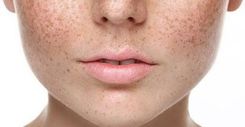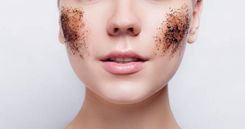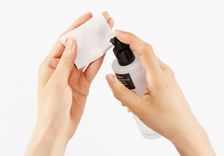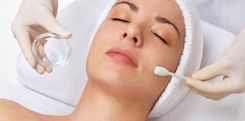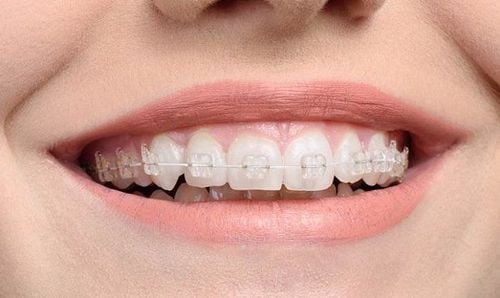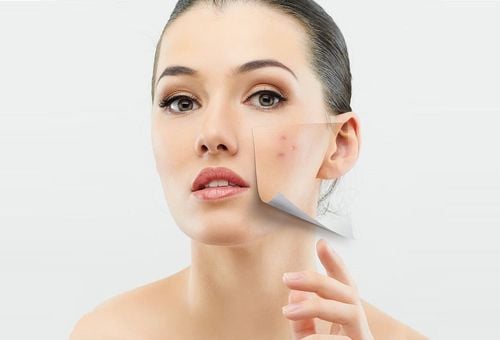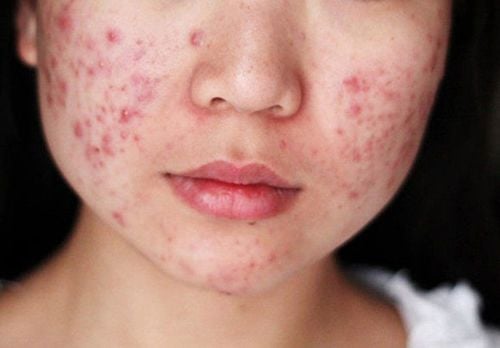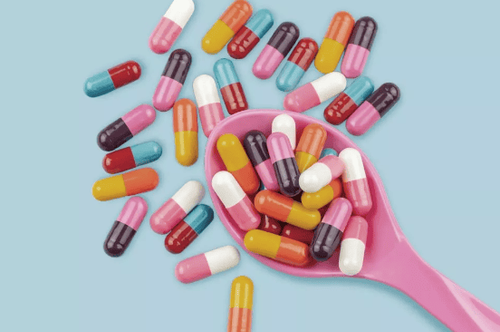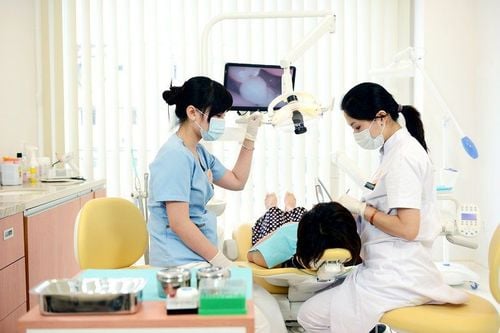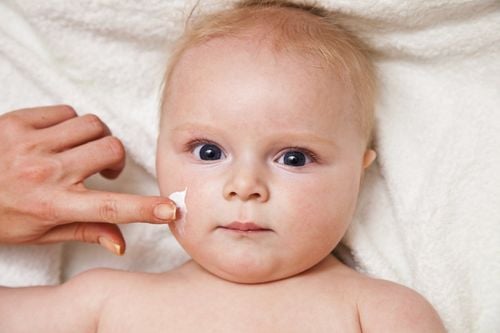This is an automatically translated article.
Although acne does not affect health much, it is unsightly for both women and men. Different types of acne will have different recognition and treatment characteristics. Therefore, readers need to know how to distinguish common types of acne to choose the most appropriate treatment.
1. What is acne? Acne is a condition in which different sized nodules appear on the face, back, chest, neck, chin, shoulder blades, buttocks, genitals,... Acne can be raised on the skin, causing no pain. mild condition), red swelling (moderate condition) or very painful and severe, pus-filled (severe condition). This is one of the common dermatological diseases, appearing due to many causes but mainly due to hormonal activity combined with a number of factors that cause clogged pores.
Acne often appears at a time when the body has a change in hormone levels such as: Entering puberty (in both men and women), when women come to the menstrual cycle, pregnancy, ... In addition, there are a number of external factors that can also cause acne such as: Change in weather, use of hot and spicy foods and irritants or a lot of dust and pollution in the air, water sources are not ensure hygiene,... Then, because of improper skin care, your skin will increase sebum secretion, sebaceous folliculitis, acne formation.
2. How to distinguish different types of acne on the body Some types of acne do not cause any effect. However, there are also types of acne that are swollen, painful, and uncomfortable. You can refer to how to recognize the types of acne on the face and body as follows:
2.1 Blackheads Blackheads are considered the first level of acne and are also the most common type of acne. Blackheads contain excess oil and dead skin cells. Among the types of acne, blackheads are easier to recognize with typical symptoms such as: Initially, tiny holes appear on the surface of the skin, the core is open to the outside, so it can be observed with the naked eye; small pimples like pinheads; acne size 1 - 2mm; Acne usually grows in large numbers, scattered on the forehead, chin, nose and cheeks.
The kernel of a blackhead is black, can grow in areas, and feels quite lumpy to the touch. Acne nodules form from a hair follicle that is clogged with excess oil and dead skin cells. The color of acne is caused by the acne nucleus protruding on the surface of the skin, exposed to external oxygen, so it oxidizes to black.
2.2 Whiteheads Whiteheads are also known by other familiar names as acne bran, acne hidden under the skin. This type of acne occurs when excess oil, dead skin cells and bacteria accumulate together to clog pores. Due to the clogged pores, the above mixture will gradually go down to the surface of the skin and then push the skin up, because the sebum is covered by the facial skin above, it is not oxidized, creating whiteheads that make the skin rough . Hidden acne is usually non-inflammatory and easy to control.
Features to identify whiteheads include: Pimples as small as pinheads, size 1-2mm, white, often growing in large numbers, scattered on the chin, forehead, nose and cheeks. , without a nucleus, located deep below the surface of the skin (only slightly raised to create rough skin), does not cause pain. Because whiteheads are located inside the skin, it is difficult to distinguish with the naked eye, but mainly by touching the skin. In some cases, the appearance of acne bran is a warning sign of some disease in the stomach or abnormalities in the reproductive organs.
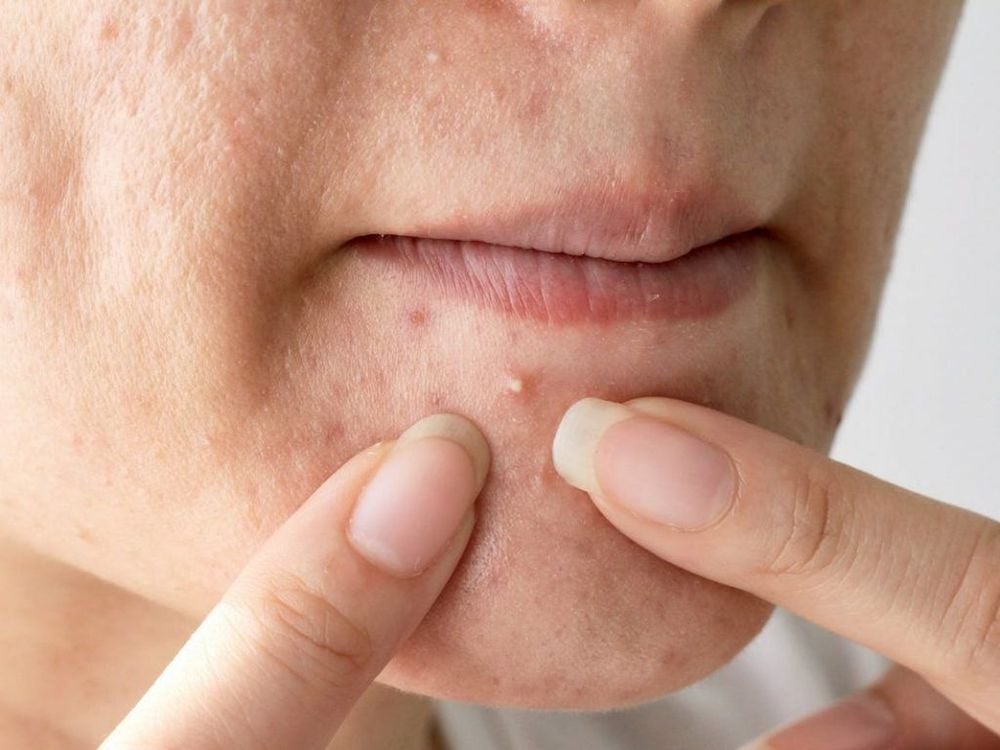
Mụn đầu trắng là một trong các loại mụn thường gặp
2.3 Cystic acne Among all types of acne, cystic acne is a severe condition of acne. This is the most severe type of acne, destroying the most skin structure, often causing pain and discomfort in the place where it appears. Acne can go away on its own, but after it heals, it will definitely leave large acne scars.
Nodules form when a hair follicle breaks at the base, pushing the surface of the skin up. Symptoms of cystic acne are: Appearance of small pimples, which gradually grow over time into red, hard, large inflammatory bumps (over 5mm in size) and cause pain if touched, inside the acne there is pus and blood. , usually without a kernel.
2.4 Pustules Pustules are another type of inflammatory acne and have a high risk of scarring. Pus in acne is the dead body of bacteria and immune cells after the body's immune cells destroy the bacteria.
Signs to identify pustules are: Yellow acne, containing pus; red acne border; cause mild pain. They look like a white pimple with a red ring around it, and the bump is filled with white or yellow pus. When there is a pustule, you should not puncture or squeeze the acne because it can cause scarring or make the inflammation worse, easily leaving deep scars.
2.5 Red Inflammatory Acne Red inflammatory acne is derived from whiteheads or blackheads. The sebum that accumulates in the hair follicles has created favorable conditions for Propionibacterium acnes (P.acnes) bacteria to grow. The immune system recognizes this bacteria and mobilizes white blood cells and T-lymphocytes to destroy P.acnes bacteria, causing an inflammatory response and acne formation.
Red inflammatory acne has the following manifestations: Red acne, size less than 5mm in diameter, causing mild pain. Inflammatory red acne can leave acne scars, so you need to pay attention to careful skin care.
2.6 Nailheads Nailheads are also known by other names as pimples or boils. It is classified as a group of diseases. Nailheads are very dangerous, mainly growing at the base of the beard hairs. Initially, the acne is small in size, but later it grows larger, leading to superinfection and can have negative effects on health.
The location where the nailhead appears will be swollen, hot, red, causing pain like a pin. In addition, some cases also have infections, fever 39 - 40°C. If not treated in time, acne can lead to infection, spread to the sinuses in the face, even lead to embolism, mouth distortion and death.
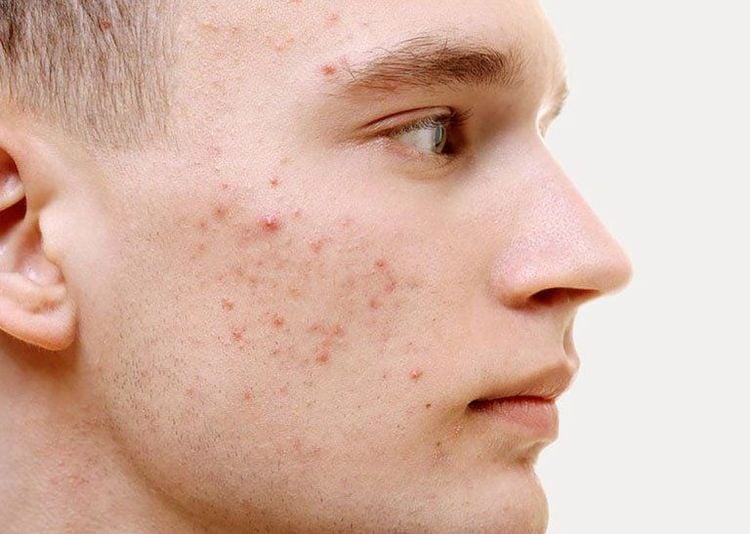
Mụn viêm đỏ có nguồn gốc từ mụn đầu trắng hoặc mụn đầu đen
3. How to prevent and treat acne? To prevent and treat acne effectively, you need to pay attention to:
3.1 Maintain a healthy, scientific lifestyle Build a scientific and moderate lifestyle to help prevent acne, shrink pores and skin Your skin will become smoother, brighter. Specifically, you should:
Try to get enough sleep, limit staying up late; Do not use stimulants, hot spicy, greasy foods, ... because they easily irritate the skin, clog pores leading to acne; Increase eating foods from nature, without preservatives and low in fat such as vegetables, fresh fruits and drink enough water to provide enough vitamins and minerals for the skin; Keep your mind at ease, avoid stress to shrink pores, avoid acne caused by stress. In addition to correcting endocrine disorders (if any), people with acne can use topical drugs with non-steroidal anti-inflammatory ingredients, combined with antibiotics in gel form or oral form to treat acne. , prevent inflammation (as prescribed by a dermatologist). With acne or blackheads, you can steam your face with coriander water, exfoliate with citric acid, use an acne serum or use a face wash in combination with a bamboo charcoal mask,...
3.2 Remove Make-up, clean skin thoroughly Makeup removal and deep cleansing is a short-term solution to remove sebum, oil and dirt on the skin, helping to clean and open pores. Therefore, you should pay attention to washing your face twice a day with a cleanser suitable for your skin. However, you should pay attention not to wash your face more than 3 times a day with facial cleanser to avoid causing an imbalance of skin moisture, leading to acne.
In addition, at the end of the day you should remove makeup to remove dirt, bacteria and makeup on the skin. Then, you should use rose water to deep clean, tighten pores and better balance skin moisture. In particular, after washing your face, you can use ice to apply on your face to shrink pores better.
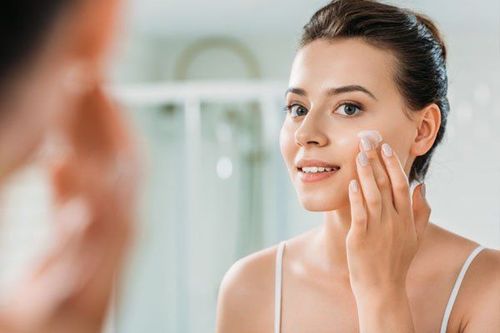
Một cách ngăn ngừa và hỗ trợ điều trị các loại mụn tuyệt vời chính là sử dụng mỹ phẩm phù hợp với làn da
3.3 Proper skin care You need to pay attention to treating all kinds of acne in time, apply the right method and absolutely do not squeeze acne, because this will cause more damage to the skin, larger pores. , more likely to cause infection. Besides, applying a clay mask at least once a week is an effective measure to help remove excess oil on the skin, unclog clogged pores, and help you own a healthier and more beautiful skin. .
Another important piece of advice that you should apply is regular exfoliation to facilitate skin renewal. Exfoliating and steaming your face about 2-3 times a week will help your skin become brighter, and pores will be tightened. However, you need to pay attention to exfoliate gently to avoid causing skin damage.
If you have oily skin, you should use oil blotting paper every 3 hours to remove excess oil on the skin, preventing clogging of pores. The skin on the nose, cheeks and forehead often has large pores and needs to be absorbed more often. In addition, from the age of 25, you should also use anti-aging creams to help keep your skin healthy, youthful and limit the condition of large pores and acne.
3.4 Use cosmetics suitable for skin A great way to prevent and support acne treatment is to use cosmetics that are suitable for your skin. You should prioritize products with benign ingredients, natural extracts, clear origins, fast absorption and non-greasy. Avoid using poor quality cosmetics to reduce the risk of skin irritation and acne.
When using cosmetics and skin care products, if you find your skin is irritated, you should stop, let the skin rest for a while and then switch to another. Products containing zinc and magnesium are recommended to use because they help balance oil on the skin, clean and shrink pores. Besides, some products with rosemary and lavender ingredients and leaves are also very good for acne-prone skin, as it helps soothe irritated skin, preventing enlarged pores. Products with salicylic acid, retinol, or retinoid ingredients also help unclog pores.
3.5 Always use sunscreen Constantly exposed to the sun can make pores bigger, skin aging faster, and more prone to breakouts. Therefore, you should apply sunscreen every day with products with SPF 30+ or higher to prevent acne and protect skin. In addition, when going out in the sun, you should wear a sunscreen jacket, a wide-brimmed hat, and sunglasses for maximum skin protection. Ideally, if possible, you should avoid being out in the sun between 10:00 - 16:00 daily.
Different types of acne will have corresponding treatment interventions. When you have acne, you should take proper care and hygiene of your skin, avoid using irritating cosmetics and have a moderate lifestyle for healthier skin.
Follow Vinmec International General Hospital website to get more health, nutrition and beauty information to protect the health of yourself and your loved ones in your family.
Please dial HOTLINE for more information or register for an appointment HERE. Download MyVinmec app to make appointments faster and to manage your bookings easily.
